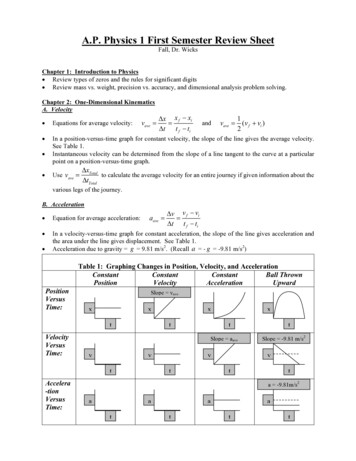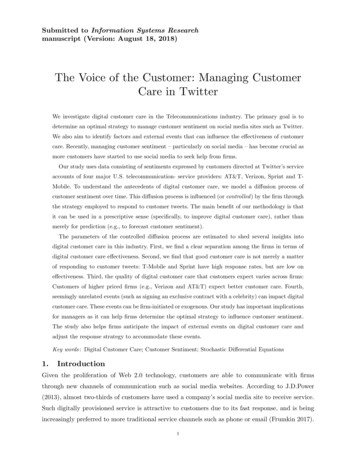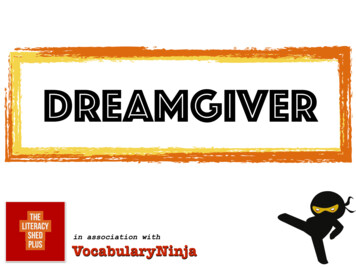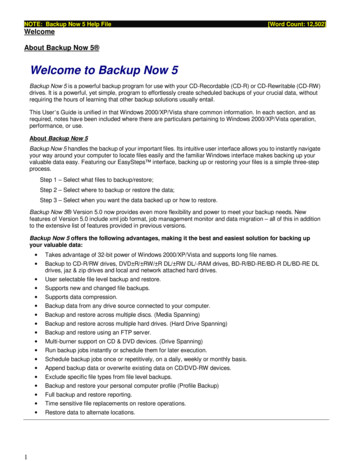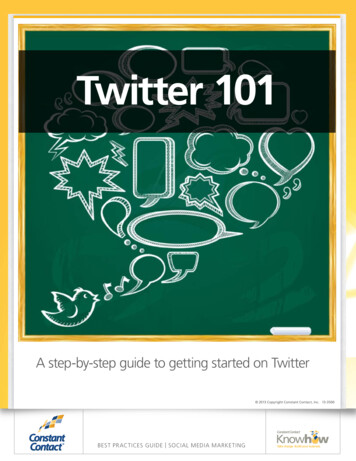
Transcription
Twitter 101A step-by-step guide to getting started on Twitter 2013CopyrightConstantContact,13-3450 2013CopyrightConstantContact,Inc. Inc.13-3500BEST PRACTICES Guide Social Media MARKETING
So you’re ready to take the jump into the wild world of Twitter. Daunting as itmay seem, there’s nothing to be afraid of! Once you get yourself familiar with theterritory, you’ll be on your way to making a big splash on Twitter.As you’re getting started, you’re most likely interested in getting a basicunderstanding of Twitter so you can effectively use it to help you achieve yourbusiness and marketing goals.In order for that to happen, it really all boils down to these three things:1. Building a targeted audience2. Creating an engaging channel3. Developing a thriving network over time to leverage when neededBut first, you have to understand how the platform works.That’s why we created this guide!In this guide, we will help you get comfortable with some important Twitter basics. We’ll alsointroduce you to some best practices that you’ll need to grow your business on this excitingsocial platform.Here’s what we’ll cover: Understanding Twitter Learning the Lingo Setting Up Your Twitter Profile Letting People Know You’re On Twitter Getting Organized What to Tweet: Coming Up with Great Twitter Content 25 Things that Make You Look Dumb on Twitter Additional ResourcesYou can read this guide from front to back or find a section that best suits your needs.However you choose to use this guide, we hope we can remove the intimidation factorinvolved with getting started.1Insight provided by Constant Contact KnowHowGet more Twitter advice on the Constant Contact Blog
A step-by-step guide to getting started on TwitterUnderstanding TwitterTwitter is the 140-character messaging service that wasoriginally developed for cell phones. That’s the main reasonthere is a 140-character limit. Today, Twitter has morphed intomore of an online service that puts you in a virtual room with alarge potential audience. But, what you’re probably wonderingis how does this thing work?Imagine a giant cocktail partyPicture yourself walking around the party listening in oneveryone’s conversations. At first it might seem pretty noisyuntil you zeroed in on a conversation you found interesting.Then, you’d introduce yourself and join in. Once thatconversation fizzles, you’d move on to the next.That’s what it’s like on Twitter. There are people chatting away, sharing ideas, opinions, and links to websites and blogs. You seek outthe people talking about topics you’re interested in. Then you follow those people.“Following” is Twitter’s fancy word for what you do when you want to see a person’s updates regularly. When people are interestedin your updates, they become your followers.With each new connection you make, you extend the potential of your network. These Twitter connections can lead to deeperconversations on other mediums, such as connecting through email, blogs, phone calls or face-to-face meetings. As with anyrelationship, there’s always the possibility of adding a new customer, client, audience member or some other unforeseen benefit.What will Twitter do for you exactly?This depends on your specific goals. But in general terms, it gives you ACCESS, both on a personal and professional level. Twitterallows you to connect with people quickly and easily, people that you would never have been able to reach before. Most importantlyTwitter allows you to LISTEN. You’ll find out exactly how to cater to the needs of your audience.Aren’t people just wasting time on Twitter?No, it’s not just people blabbering about what they had for dinner and their cats. Or what their cats had for dinner. It’s people sharinglinks, news, photos, ideas, and directly and indirectly selling their stuff. Yes, those blabbering dinner and crazy cat people are theretoo, but you don’t need to worry about them.Focus only on the people you want to know more about, that bring value to your network, and the people you want to connect withdown the line. These are the people whose messages, or updates—or tweets as there known on Twitter—you are interested in. Thisalso includes people who would be a potential audience for your stuff, whatever that may be.2Insight provided by Constant Contact KnowHowGet more Twitter advice on the Constant Contact Blog
A step-by-step guide to getting started on Twitter“This sounds like a giant time suck!”The amount of time you spend on Twitter is entirely up to you. Realistically, after some preparation, you can spend as little as 15minutes a day on Twitter and start to see the benefit. But as with any endeavor, the more time you put in, the more benefits you reap.“Is there a wrong way to use Twitter?”Some people think it’s a place to talk about what you’ve had for lunch. Others think it’s a touchy-feely “we’re going to change theworld” type of atmosphere. And yes, there are those who even want to show you how to make millions of dollars from single tweet.Who’s right?They all are. That’s the beauty of Twitter.Just like in the offline world, you seek out like-minded people. If you don’t like what someone else is doing, that’s okay. One click is allit takes to keep someone from bothering you.If there’s no wrong way to use Twitter, is there a right way?Remember, the platform is still relatively new. Everyone is figuring it out as they go along and everyone is learning from each other.Failing, succeeding, and having a good time. But just like anything that’s new, it’s nice to get a little perspective. So the key thing toremember is that you’re looking to develop relationships with people. With that approach, you’ll be headed down the right path.Before we get started, let’s make sure you’re familiar with some key terms and language beingused on Twitter.3Insight provided by Constant Contact KnowHowGet more Twitter advice on the Constant Contact Blog
A step-by-step guide to getting started on TwitterLearning the LingoTwitter has a language of its own. If you think you’re fluent already, skip ahead to the next section. If not, hereare the terms you need to know!DM/Direct Message: A private note between twoRT/Retweet: This is the Twitter equivalent of forward-to-a-users on Twitter. The person receiving the message mustfriend. When someone posts something you find interesting, youfollow the person sending it and the message is bound by thecan retweet it, share it, with all the people who follow you.140-character limit.Search: Since the majority of tweets are public, you can useFollow: The act of connecting with someone on Twitter.Twitter’s search feature to look for tweets containing a keywordPeople who have elected to follow you will see your tweets inor phrase. The search results will update in real time with anytheir timeline. You are not obligated to follow people back andnew tweets that contain the word or phrase you searched for.you have the ability to block followers (usually used only forTimeline: The chronological listing of all tweets in a given feed.spammers) from seeing your posts.Following: Electing to see someone’s tweets in your owntimeline. Follow people and companies that you’re interested inhearing from.Handle: Your Twitter username is referred to as your handle,and is identified with the @ symbol. For example, ConstantContact’s handle is @constantcontact. The @ is used to referto a specific person or company and link to that account onTwitter within a tweet.Hashtag: Words preceded by a # sign (i.e., #ctctsocial)can be used to tie various tweets together and relate them toa topic, be it a conference, TV show, sporting event, or anyTrending Topics: Along the left side of the main webinterface, Twitter lists 10 topics that are “hot” on Twitter basedon certain algorithms. You can see trending topics for all ofTwitter or for certain geographic areas.Tweet: What posts are called on Twitter.Tweetup: A term for in-person events (i.e., meetups) thatspring from Twitter connections. Tweetups are typically informalgatherings that let Twitter followers meet in real life. Coordinatorsoften use a hashtag to unite tweets related to the event.Unfollow: By unfollowing someone, you no longer receivetheir updates in your own timeline.happening or trend of your choosing. Twitter automaticallylinks all hashtags so users can search for other tweets using thesame tag.Lists: A way to combine select people you follow onTwitter into a smaller feed. A list can be made up of friends,competitors, people in the same state: anything you want.Now you know how to talk the talk on Twitter. Let’smake sure you know everything you need to knowabout setting up your Twitter Profile.Lists let you view a slice of your followers at a time and are agreat way to focus on specific folks when you’re following alarge number of people. They can also be marked as public orprivate.4Insight provided by Constant Contact KnowHowGet more Twitter advice on the Constant Contact Blog
A step-by-step guide to getting started on TwitterSetting Up Your Twitter ProfileThe anxiety of not knowing how to get set up on Twitter plays a big part in why many businesses decide to put off getting started.What’s most important when setting up your Twitter profile is that you want to make it easy for people to recognize your businessand connect with you right away. You can do that with your Twitter handle, your profile picture, and the information you decide tooffer.Here are a few things to keep in mind when getting set up.1. Choose the right Twitter handleThe first step in getting started on Twitter is creating your account. When creating your account, it’s important to remember that yourusername—or as it’s called on Twitter: your “handle,” is outward facing and will be what the public uses to identify your business.Hopefully, your business name will be available (Constant Contact’s handle for example is @ConstantContact,) but if not, you’ll wantto come up with something that will still make sense to your followers (for example: “In a Pickle Restaurant” in Waltham had to use@ InAPickleRest).You want your handle to be around 10 – 15 characters so your customers can “mention” your business without using too many of the140 characters they have to use.2. Create a bio that captures your businessTwitter is widely recognized as one of the most open social networks, because most of the communication on the site takes place infront of people in the timeline (rather than on individual pages or groups). Keep in mind when creating your bio, more people will findyou on Twitter that have no previous knowledge of who you are or what you do.If you had just a few seconds (or in this case 160 characters) toexplain your business to a complete stranger, what would you say?That will be your bio.3. Upload a photo or image that makes you standoutDon’t underestimate the importance of picking the right pictureor image for your profile (and please, please, please don’t send atweet until you have one uploaded.) For businesses, the perfectprofile image will be one that your customers already know andassociate with your business. For many, this will be your companylogo. For individuals, you’ll want to use a close-up head shot andmake sure you are the only person in the photo. (You do have theoption to change your profile picture in the future, but we don’trecommend it, at least until you’ve established yourself.)5Insight provided by Constant Contact KnowHowGet more Twitter advice on the Constant Contact Blog
A step-by-step guide to getting started on Twitter4. Introduce yourself by sending your first tweetNow is the perfect time to send your first tweet! It’s not going to be anything earth shattering, and you won’thave any followers (yet) to see it, but it will let people know you are a real person or business and not a robot orspammer. Make the tweet something simple; your introduction to the Twitter world.5. Find the right people to followWho you follow on Twitter will dictate the type of content you have access to and the quality of the relationshipsyou’re able to establish. For this reason, you’ll want to set up some criteria based on your experience, your industry,and what you’re trying to accomplish. People you may want to follow could include: friends, professionals in yourindustry, other local businesses, colleagues, and even current or potential customers.When you’re starting out, the key is to follow businesses similar to yours that are doing it well. Don’t mimiceverything they tweet, but pay attention to how they are engaging and the type of content they share.Keep your eye on Twitter’s “Who to Follow” feature (in the left column) for recommendations of people andbusinesses that fit your interests.Once you have your profile set up, you’ll be ready to get started. Remember, success on Twitterstarts with building a targeted audience for your business or organization.In the next section, we’ll walk you through what that means when you’re starting out.6Insight provided by Constant Contact KnowHowGet more Twitter advice on the Constant Contact Blog
A step-by-step guide to getting started on TwitterLetting People Know You’re on TwitterThere’s a good chance that Twitter isn’t your first experiencewith online marketing. Depending on where you’re at in theonline marketing process, you likely already have a network ofonline connections either through social media or via a list ofemail contacts.When jumping head first into Twitter, you’ll want to start withyour current network of supporters both online and off, to helpbuild your following.Let’s take a look at how you can leverage your network, tojumpstart your Twitter audience.1. Announce your new social endeavor onother social networksIf Twitter is a cocktail party, doesn’t it make sense that youinvite the people you already know and have a relationshipwith?Start by reaching out to the people who have alreadyconnected with you on other social networks. If they’re onTwitter too, there’s a good chance they’ll want to follow youthere as well.2. Send a targeted email to your list of emailcontactsWhenever you’re getting started on a new social network,take the time to tell your email contacts about your new socialendeavor. There’s a reason sites like Facebook, Twitter, LinkedIn,and Pinterest ask for your email address when you sign up andsend emails to your inbox. Email is the most effective way todrive action behind the stuff you do on social media. Dedicateat least one email to letting people know you’re on Twitter.3. Link your regularly scheduled newsletter toTwitterAfter you’ve notified your audience that you’re on Twitter, youcan keep driving traffic to your profile by including a button orbadge in your emails that links to it. With Constant Contact,you can quickly add social media buttons to any email to givereaders the chance to easily connect with you.4. Make sure your website links to TwitterJust like you want to link your regularly scheduled emails toyour Twitter profile, you’ll also want to make it easy for peoplewho visit your website to find your activity on Twitter as well.Twitter makes it easy to embed your Twitter feed right ontoyour website or you can simply add links to Twitter on yourwebsite homepage. If you have a blog for your business, you’llalso want to connect that to your Twitter profile as well.5. Ask customers, clients, and members to findyou on TwitterDon’t limit yourself to just your online interactions. Make sureyou’re providing a clear call-to-action for every customer,client, member, or volunteer who interacts with your businessor organization. If you have a brick and mortar store, you canput up signs at your register encouraging employees to askcustomers to find you on Twitter. You can even use a QR codeto give customers the chance to connect with you on Twitterwith a quick scan of their mobile device.Which ever way you decide to promote your activityon Twitter to your current network of fans, readers,and customers—just make sure you’re covering yourtouch points and providing a clear call-to-action toencourage them to take the next step.7Insight provided by Constant Contact KnowHowGet more Twitter advice on the Constant Contact Blog
A step-by-step guide to getting started on TwitterGet OrganizedAs you build your following and begin to invest more time into Twitter, you may find it’s not always easy to keep things in order.With so much happening on Twitter, even the most experienced users can start to feel overwhelmed.The good news is that Twitter comes with plenty of tools that can help you stay organized and get more from the social platform.Here are a few things you may want to consider:1. Use Twitter Lists to your advantageTwitter Lists are a cool feature that lets users organize thepeople they follow into specific groups based on their industry,relationship, expertise, etc.Consider this simple approach to organizing your first threelists:Peers – This list would contain people within your industry thatare at about the same level as you. These could be people youalready have strategic partnerships with or people you’d like topartner with. These relationships can prove extremely valuableas you move up the ranks with your business.Pros – This list is for experts or thought leaders in yourindustry,or the people with businesses at a level you’d like toreach. Use this list to monitor how they’re using social mediaand what they’re talking about. What can you apply to yourbusiness?Patrons – This list contains people who are already customersor clients, or are people you’ve deemed likely to buy, donate, orvolunteer. Watch this list to identify their interests and keep aneye out for any questions being asked that you could answer.Monitor for customer feedback (positive or negative) that youcan respond to and expand on your answers with your owncontent to drive potential customers to your website.Once you have these lists in place, you can start identifyingthe people you should add to them. To start this is as simpleas adding the people you’ve indentified as fitting into oneof these categories. As you monitor Twitter and follow thediscussions, you’ll organically find new people to add to theselists.2. Save some searchesSimilar to Lists, Saved Searches let users organize their content,but do it based on a specific topic rather than on specificusers. Saved searches work exactly like they sound. You find atopic of interest or relevance to your business, search for it inTwitter’s “Discover” tab, and then save it for future reference.After saving it, you can easily go back and see results as theyappear in real time.Some ideas for searches to save include: Your business name Your personal name Your city/town Relevant industry topics Popular hashtagsSearches can help you keep track of what people are sayingabout your business and also give you a chance to accessrelevant content your followers will love.3. Schedule tweets with HootSuiteIf you’re worried about Twitter getting in the way of your busyschedule, a free platform like Hootsuite can be a big help.In addition to helping you manage and monitor your socialmedia activity, Hootsuite gives you the ability to scheduletweets ahead of time.Scheduled tweets are great for sending reminders aboutupcoming events, limited time offers, or anything elseyou might have going on at your business. For nonprofits,scheduling tweets during a fundraiser can help generatedonations without getting in the way with your busy schedule.4. Get updates sent straight to your inboxWhen you set up your Twitter account, you’ll be able to opt-into receive email updates about all your Twitter activity. (Or youcan update your preferences in your account settings.)8Insight provided by Constant Contact KnowHowGet more Twitter advice on the Constant Contact Blog
A step-by-step guide to getting started on TwitterThis is a great tool for keeping tabs on mentions, retweets, and new followers.You may also want to check out a free tool like Nutshell Mail. With Nutshell Mail you can get a digest of all yoursocial media activity on sites like Twitter, Facebook, and LinkedIn sent directly to your inbox.Both of these tools are great for keeping up with your Twitter activity without having to check into your accountcontinuously throughout the day.5. Share your emails automatically with Simple ShareYour email newsletter is a great source of Twitter content. People follow you on Twitter because they trust you’lloffer them something of value. They subscribe to your emails for the same reason.That’s why we created Simple Share, a free tool that lets you share your emails automatically right when they goout. With Simple Share, all you’ll need to do is choose your Twitter profile, come up with a tweet to accompany alink to your email, and hit schedule. (Learn more about Simple Share!)In addition to your email newsletter, there are plenty of great sources of content all aroundyou. In the next section, we’ll take a closer look at the places you can turn to when you’restruggling to come up with something to tweet.9Insight provided by Constant Contact KnowHowGet more Twitter advice on the Constant Contact Blog
A step-by-step guide to getting started on TwitterWhat to Tweet: Coming Up with Great Twitter ContentAt this point, you’re more than ready to join the conversation onTwitter.But what are you going to tweet about?With over 400 million tweets being sent each day, you may feellike you’re the only one having trouble coming up with greatTwitter content—you’re not.The type of content you share on Twitter will have a lot to dowith the type of audience you’re able to attract and thus, theresults you’re able to achieve.That’s why it’s so important to start by thinking about who thosepeople are. What type of content would your ideal customer,client, members, or supporter be most interested in seeing?Some of that content may come directly from you — like a blog post, email newsletter, or a link to your website. But thereare plenty of other sources of great content all around you just waiting to be shared.Here are 4 places to find inspiration for content when you don’t know where to look:1. Look to others in your industryOne of the best ways to find inspiration is to look at what other people in your industry are talking about. Can you offer adifferent viewpoint or piece of advice on a topic?There are two main ways that Twitter can be used to quickly and easily share other users’ content:1. Share someone else’s post with a retweet2. Share a link to someone else’s content and mention them directlyYou may also want to interview other experts in your industry. Let’s say you’re a social media consultant and you’reattending a conference. Ask the speakers for a quote for your blog or website after the presentation. Most likely they’ll loveto be featured and you’ll look good by association.Try it. Soon others may start asking YOU to be featured in their content!2. Interview one of your customersAsk one of your own customers if they want to be featured in one of your posts. This could be a loyal customer or even anew customer. Write about their business challenges and how they’ve overcome them. Customer stories are an engagingway to create more visibility for both your business and theirs. Ask them to share the story with their own network as well.3. Ask your employees for topic ideasCreate a simple system to gather topic ideas from those who know your business best your own employees. If you havea store, place a fishbowl somewhere with some blank forms and have your employees submit ideas. If you are on online10Insight provided by Constant Contact KnowHowGet more Twitter advice on the Constant Contact Blog
A step-by-step guide to getting started on Twitterbusiness, create a private link somewhere online or through an email for employees to submit ideas. You could even makethis fun and create a contest for others to vote on a few of the ideas. Engage your employees while creating great contentideas.4. RSS FeedsThere’s a good chance you already have some favorite blogs, news sites, or other sources of content you like to followonline.You can use a tool like an RSS feed to easily keep tabs on your favorite news sources.Once you’ve figured out what you want to say, make sure you’re sharing it in a way that’s going to help get you noticed andnot overwhelm your audience.To do that, you’ll want to make sure you’re paying attention to how people are engaging with your content. Your audiencewill tell you what’s working, what’s not, and where you may need to make improvements. All you need to do is listen!Here are a few content essentials you’ll want to keep in mind. Talk with your audience, not at your audience Keep your content related to your field and your audience Use the general rule for content: 80% information, 20% promotion It’s not about sending a message, it’s about getting responses Be yourself!As valuable as it is to know how to do things right, if you’re just getting started, you probably want some insightinto things that could be labeled as “wrong.” So, last but not least, we’ll be taking a look at 25 things that you’ll \want to avoid when getting started on Twitter.11Insight provided by Constant Contact KnowHowGet more Twitter advice on the Constant Contact Blog
A step-by-step guide to getting started on Twitter25 Things that Make You Look Dumb on TwitterIt’s normal to feel at least a little anxious when getting started on Twitter.Don’t worry. A majority of Twitter users are learning something new about the platform every single day.Rather than having to go through the heartache of learning from your mistakes, we decided we’d give you a helping hand.Here are 25 common Twitter mistakes you’ll want to avoid when getting started on Twitter:1. Not leaving enough space to retweet7. Not responding to TweetsThe first lesson every Twitter newbie should learn: just becauseyou have 140 characters, doesn’t mean you need to usethem all. It’s usually a good idea to keep posts to about 120characters to allow people who retweet with the RT format theability to do so without having to edit your tweet for length.If you’re not being social, why are you on social media? Youmight not be able to respond to everything, but do your bestto answer questions and address any negative feedback. Anddon’t forget to say thanks when it’s positive.2. Not shortening links in your tweetsThis is one of the most common mistakes and it doesn’t needto be. Check out link shorteners like bit.ly or ow.ly. You’ll alsobe able to track the number of clicks the links you share getwith these tools.3. Looooong Twitter handlesAre you noticing a pattern? If your handle is longer than thefirst half of your tweet, you’re losing valuable space. Keephandles as short as possible so you have enough room toactually write something.4. Too much self promotionA little self promotion is good for any business but, if yourtimeline is riddled with “I’s or We’s” and your only retweets areabout you, then you’re doing too much. Follow the 80/20 rule.Post 80% helpful or entertaining content and save 20% for theself-promotional stuff.5. #HashtagAbuseHashtags are without a doubt the most interesting part ofTwitter. But, in addition to sometimes being hilarious, they areextremely helpful for organization purposes. Don’t abuse thehashtag, save it for when you need it.8. Automatic direct messagesToo many people send automatic direct messages to newfollowers. Don’t do this. You don’t want the first impressionthat you make with your customers to be from a robot.9. QR code avatarNowadays you see QR codes in some crazy places. Don’tlet your Twitter account be one of them. Make your avatarsomething that reflects you or your brand.10. Too much abbreviationSometimes you’re going to have to abbreviate but try not toabandon grammar to the point of being unreadable.11. Spelling errorsSpelling errors are going to happen, but try to keep them toa minimum. People will notice them and it can make yourbusiness look sloppy. Review before you hit send. Watch forsome common misspellings, like There/Their/They’re/Your/You’re.12. Tweeting without a strategyNever tweet just for the sake of tweeting. Take some time todecide why you’re on Twitter and what you want to get from it.6. Too much negativity13. Too much dialogue, not enough contentNo one wants to follow a depressing tweeter. Keep yourTwitter is all about sharing content. You want to engage withfollowers but you also want to give them content that makesthem engage with you.tweets positive and your followers will act accordingly.12Insight provided by Constant Contact KnowHowGet more Twitter advice on the Constant Contact Blog
A step-by-step guide to getting started on Twitter14. Too much content, not enough dialogueyou’re all about and give them a reason to follow. And makeConfused yet? It’s all about finding a balance. Unless you’re anews outlet, then people are looking for more than just news.Use your content to drive engagement from your followers andstart a discussion.sure it’s up-to-date.15. Only tweeting 9-580.5% of small businesses DO NOT link their sites totheir social networks. Don’t let your business be part ofthat group. They’re missing potential followers and mostimportantly customers.No one expects your Twitter to be a 24/7 operationbut, your followers don’t log off when you go home for theday. Hootsuite is a great option for managing and schedulingtweets.16. Tweeting without the factsThis is the number one way to hurt your credibility and tickyour followers off. Be a helpful source of information in yourindustry, not a rumor mill.17. Tweeting too oftenThere’s no set formula for how much you should be tweeting.But, unless you’re the most interesting person in the world,chances are if you’re clogging up their timeline they’ll get turnedoff in a hurry.18. Bad talking competitionIf you don’t have anything nice to say, don’t say anything at all.Building conn
A step-by-step guide to getting started on Twitter Understanding Twitter Twitter is the 140-character messaging service that was originally developed for cell phones. That’s the main reason there







